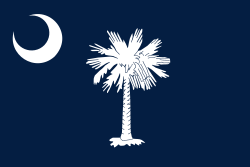| 6th South Carolina Cavalry Regiment | |
|---|---|
 Flag of South Carolina | |
| Active | July 23, 1862, to 1865 |
| Allegiance | South Carolina Confederate States of America |
| Type | Cavalry |
| Nicknames | Dixie Rangers Aiken's 16th S. C. Partisan Rangers 1st Partisan Rangers |
| Engagements | American Civil War Battle of Spotsylvania Court House Battle of Monroe's Crossroads |
| Commanders | |
| Current commander | Colonel Hugh K. Aiken |
The 6th South Carolina Cavalry Regiment (also called Dixie Rangers, Aiken's Partisan Rangers and 1st Partisan Rangers) was a regiment of cavalry in the Confederate States Army during the American Civil War. They were from the state of South Carolina and served at various times in both the Eastern and Western theaters.